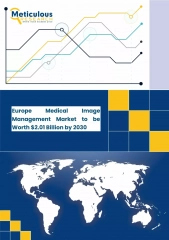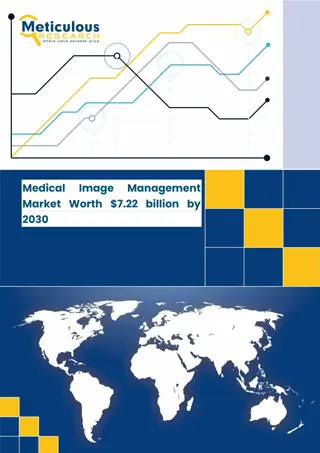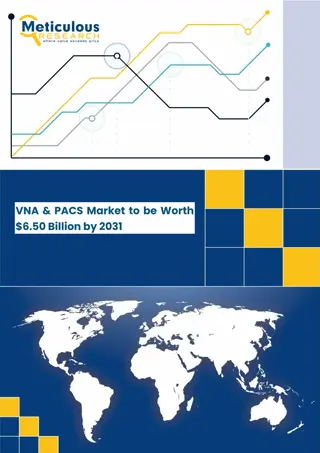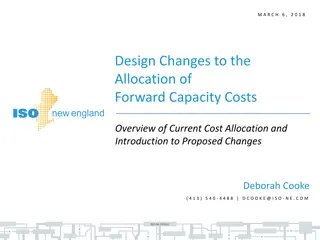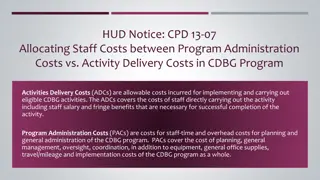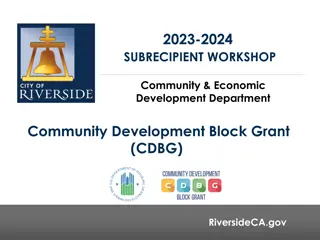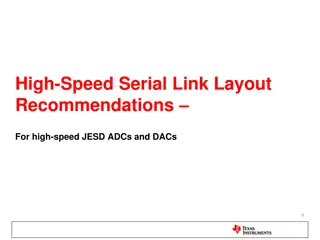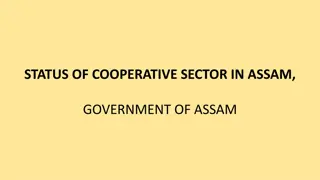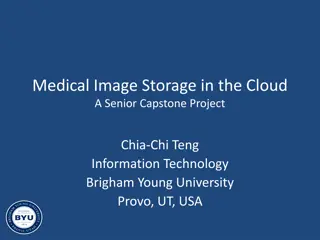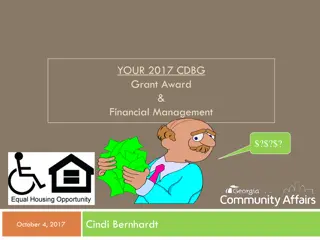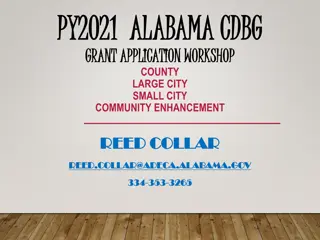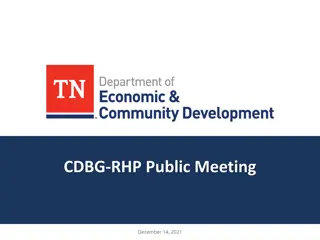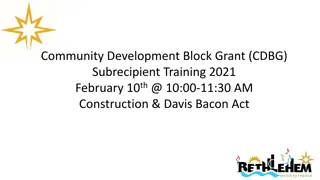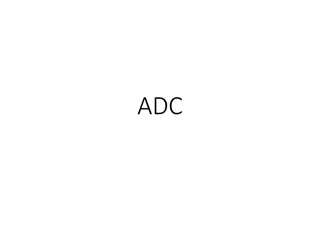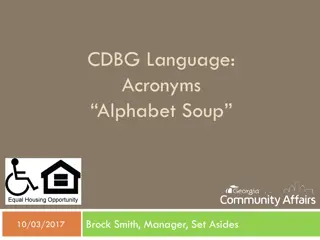Understanding Cost Allocation in CDBG Program: ADCs vs. PACs
Activities Delivery Costs (ADCs) in the CDBG program cover non-profit staff expenses related to implementing eligible activities, while Program Administrative Costs (PACs) encompass planning and general administration expenses. ADCs include salaries and benefits for staff directly involved in activities, whereas PACs involve overhead costs for program management. Examples of ADCs and PACs illustrate the distinctions between the two types of costs in CDBG programs.
Download Presentation

Please find below an Image/Link to download the presentation.
The content on the website is provided AS IS for your information and personal use only. It may not be sold, licensed, or shared on other websites without obtaining consent from the author. Download presentation by click this link. If you encounter any issues during the download, it is possible that the publisher has removed the file from their server.
E N D
Presentation Transcript
HUD Notice: CPD 13-07 Allocating Staff Costs between Program Administration Costs vs. Activity Delivery Costs in CDBG Program Activities Delivery Costs (ADCs) are allowable costs incurred for implementing and carrying out eligible CDBG activities. The ADCs covers the costs of staff directly carrying out the activity including staff salary and fringe benefits that are necessary for successful completion of the activity. Program Administration Costs (PACs) are costs for staff-time and overhead costs for planning and general administration of the CDBG program. PACs cover the cost of planning, general management, oversight, coordination, in addition to equipment, general office supplies, travel/mileage and implementation costs of the CDBG program as a whole.
What are Activities Delivery Costs? Activities Delivery Costs (ADCs) in this Public Service/Shelter Diversion Program are non-profit staff costs for carrying out eligible CDBG activities, providing the non-profit meet the compliance requirements under the public service provision and the CDBG program in general. The ADCs covers the salary and fringe benefits of staff directly carrying out the activity (rather than an Executive Director or Chief Operating Officer); staff positions are: case worker, diversion specialist, youth crisis specialist, etc
What are Activities Delivery Costs? Examples of CDBG ADCs: Salaries of employees for the time devoted to implementing and carrying out specific eligible CDBG activities. The fringe benefits may include: Medical Benefits, unemployment comp, Social Sec. (FICA), Worker s Comp.
What are Program Administrative Costs? Program Administration Costs (PACs) are costs for staff-time and overhead costs for planning and general administration of the CDBG program. PACs cover the cost of planning, general management, oversight, coordination, in addition to equipment, general office supplies, travel/mileage and implementation costs of the CDBG program as a whole.
What are Program Administrative Costs? Examples of CDBG PACs: Salaries of executive officers and staff with general program oversight responsibilities such as Community Development Directors, Planners, and their administrative staff. (Specifically for CDBG-DOH Shelter Diversion Program, this will cover the cost for; the town staff-time, the program administrator from United Way or Supportive Housing Works, Always Homes, etc ) Leased office space for staff carrying out the CDBG program. Time spent developing general CDBG program policies and procedures, such as CDBG application and development of procedures for monitoring sub-recipients for performance. Staff time to develop the Consolidated Plan/Action Plan and Consolidated Annual Performance and Evaluation Report.
What are Program Administrative Costs? Examples of CDBG PACs: (continued) Dissemination of information on the CDBG program, eligible activities, and how to apply. Dissemination of education on fair housing. Costs of data gathering and studies on the need in a CDBG-eligible area. Travel costs incurred specifically for carrying out eligible activities, i.e.; mileage reimbursement for meeting with targeted clients, transportation to and from the meetings General office supplies such as, computers, desk, chairs, paper, pens, pencils, staplers, paper clips, etc
DOH CDBG Public Services (Shelter Diversion Program) Activities Delivery Costs (ADCs) are categorized as Program Costs. Program Administration Costs (PACs) are categorized as Admin. Costs
Budget details for CDBG Public Service Activities: Connecticut Department of Housing Exhibit 4.7I.2 Budget for CDBG Public Service Activities (Shelter Diversion Program only) Agency Name: Program Name: -Activities Delivery Costs (ADCs) = Program Costs % Other Funding Sources Other Funding Sources Allocated Program Expenses (1) Details Amount % CDBG CDBG Other Funding Details A. Program Cost/Activity Delivery Costs (ADCs) Salaries & Wages Diversion Specialist, Case Manager - - Fringe Benefits Med. Ins., Workman Comp, Soc. Sec. (FICA), etc - - Total Program Cost - 0% - - B. Program Administrative Costs (PACs) - - Rent Proportionate Share of Total Annual Expense - - Telephones Proportionate Share of Total Annual Expense - - Electricity Proportionate Share of Total Annual Expense - - Gas/Heating Fuel Proportionate Share of Total Annual Expense - - Postage Proportionate Share of Total Annual Expense - - Supplies All Supplies Associated with Program - - -Program Administrative Costs (PACs) = Admin. Costs Insurance Proportionate Share of Total GL Insurance - - Travel/Mileage Travel between Sights and Client Homes - - Consultant Services Program oversight administration Total Admin. Costs (2) - 0% - - Total Program + Admin. Costs - 0% - 0% - Total Unduplicated Clients 0% 0 0% 0 Notes: (1) Allocated Program Expenses are the proportionate share of total agency expenses related to the operation of this specific program. (2) Administrative costs must not exceed 20% of the CDBG grant amount.
For more information, please contact: Paula (Ploynapas Thantaha) Economic & Community Development Agent Department of housing 505 Hudson St., (2ndfloor) Hartford, CT 06106 Phone: 860-270-8181 Email: Ploynapas.Thantaha@ct.gov


